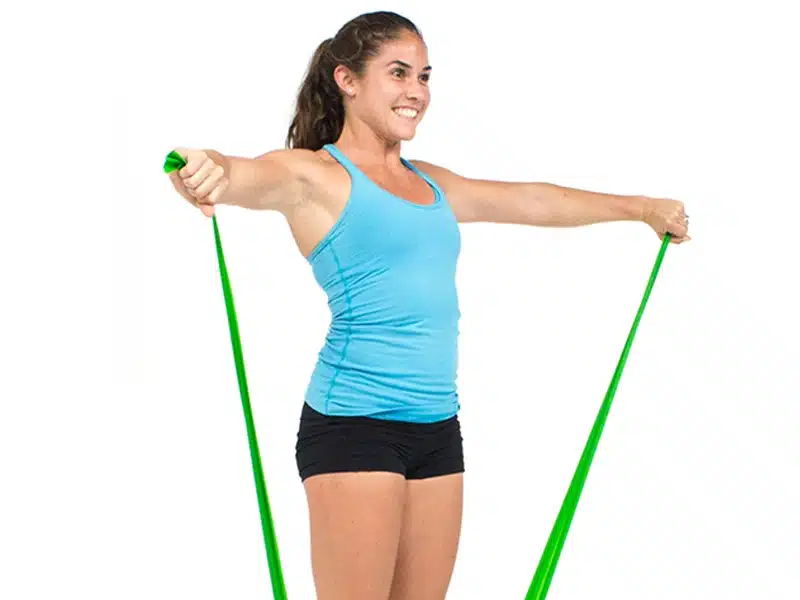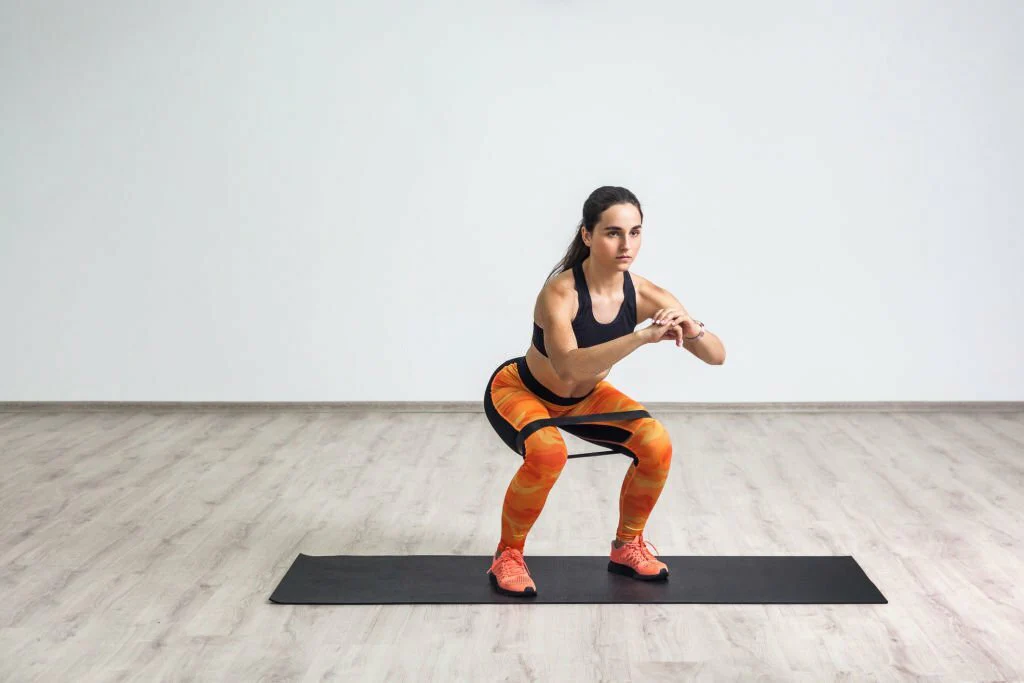How to Use Resistance Bands for Full-Body Workouts at Home

My dear Reader, I hope that after reading this article, it will be easy for you to understand how to use resistance bands for full-body workouts.
Resistance bands are a versatile, cheap, and effective way to have full-body workouts in the comfort of your home. These are portable exercise tools that can help you achieve strength gains, flexibility, and over all fitness without having to use heavy equipment or join a gym.
This guide will give you a complete plan to ensure that every major muscle group is targeted using resistance bands, thus giving you a comprehensive workout from your home.
Types of Resistance Bands
Various kinds of resistance bands are available, each suited to specific workouts and fitness levels. Here are the major types of these bands:
1: Loop Bands

Description:
They form continuous loops; hence, they are primarily used for lower-body exercises such as squats and side leg lifts.
Usage:
Ideal for improving thighs, hips, and butts. Furthermore, they can also be applied in the development of other upper body muscles, such as shoulders and arms.
Resistance Levels:
They usually come in light, medium, or heavy resistance.
2:Therapy bands

Description:
Also called flat bands; therapy bands are long, straight strips that do not form a loop. Mostly used for physiotherapy purposes in rehabilitation centers.
Usage:
Best for stretching, therapy routines, and moderate strength training. Additionally, they can be utilized to enhance one’s flexibility concerning joint movement.
Resistance Levels:
Are available in different strengths, which could be color-coded to show variations.
3: Tube Bands With Handles

Description:
These bands have handles at each end and look like cylinders. They are very flexible since there is a wide range of exercises where tube bands can be applied.
Usage:
Suitable for all-over-body workout routines involving activities such as bench presses, rows or biceps curls. The grips on the handles offer good control, making it easier to work out using these bands.
Resistance Levels:
It often comes in several strength categories, usually indicated by colors.
4: Figure-8 Bands

Description:
They are constructed in the shape of an 8 or an hourglass with soft straps on both sides.
Usage:
Ideal devices for arm exercises, e.g., chest flies or bicep curls, provide focused tension while being user-friendly equipment, among other things.
Resistance Levels:
Many times, we find different resistances that meet various needs concerning stamina enhancement.
5: Pull-Up Assist Bands

Description:
Longer, thicker versions join together, thus forming a circular shape that is used for pull-ups and other bodyweight exercises.
Usage:
These are often used to support pull-ups, dips, and muscle-ups. At the same time, they do stretching and mobility exercises.
Resistance Levels:
Depending on how much help you need, they are offered in a range of light to very heavy resistance levels.
6: Mini Bands

Description:
They are small loop bands that target the lower body for specific training purposes.
Usage:
Ideal for targeting hip abductors, glutes, and quadriceps. These can be used during warm-ups as part of a physical therapy exercise or even an isolated strength training drill program that is quite extensive.
Resistance Levels:
Light, Medium, and Heavy versions are available
7: Lateral Resistance Bands

Description:
These usually come with cuffs or loops that can fit around your ankles or legs.
Usage:
Suitable for lateral movements like side-gliding or change-of-direction exercises. They are commonly seen in sports practice sessions as well as physiotherapy programs meant for recovery from injuries.
Resistance Levels:
Provided in various resistances appropriate for different power requirements within the conditioning sphere.
Choosing the Right Band
The right resistance band to select will depend on what you want to achieve with your workout goals; it also depends on the type of routine you have planned out as well as your current strength levels. This means new people should start with less resistant bands, progressing towards stronger ones as they build up their muscles. It is good to vary one’s workouts by using different kinds of bands so that the process gets more interesting and productive.
The Benefits of Resistance Bands
Before we delve into the exercises, let us explore the advantages that come with incorporating resistance bands into your exercise routine:
Versatility:
Multiple exercises for different muscles can be performed using resistance bands.
Portability:
Due to their lightweight and small size, they can be easily moved and used anywhere.
Adaptability:
Different resistance levels determine their suitability for all fitness levels.
Joint-Friendly:
They provide a lower-impact alternative compared to free weights, hence reducing the chances of injuries.
Cost-Effective:
When compared to traditional gym equipment, resistance bands are relatively cheaper.
Full-Body Resistance Band Workout: The Ultimate Guide
Here’s an inclusive, detailed plan of exercises on How to Use Resistance Bands for Full-Body Workouts at Home
1. Wood Chopper

Target Muscles: Obliques, shoulders, and core
How to Perform:
Attach the resistance band low on an anchor point.
Stand with feet shoulder-width apart and hold the band in both hands.
Begin from one side near the floor, then twist while lifting your trunk, pulling through the band diagonally towards your opposite shoulder.
Bring it back in controlled movement at the start position.
Do 3 sets of 12–15 reps on each side
2. Pull-Apart

Target Muscles: Upper back, shoulders
How to Perform:
Hold the band at shoulder width with arms extended forward at chest height using both hands
Pull the band apart as if squeezing it between your shoulder blades.
Return steadily to the starting position
Do 3 sets of 15 – 20 reps
3. Deadlift

Target Muscles: Hamstrings, glutes, lower back
How to Perform:
Hold the handles with your feet at hip-width apart when standing on the band
Hinge forward from your hips, maintaining a straight back, and lower until you feel a stretch in your hamstrings.
Squeeze your glutes together as you stand up again.
Do 3 sets of 10–12 reps.
4. Overhead Pull-Apart

Target Muscles: Shoulders, upper back
How to Perform:
Hold the band overhead with arms fully stretched out.
Pull the band apart, bringing down your arms till they are parallel to the floor,
Go back to the initial position again.
Do 3 sets of 12–15 repetitions.
5. Chest Fly

Target Muscles: Chest, shoulders
How to Perform:
Attach the band at chest height on a sturdy anchor point.
Stand facing away from the anchor, holding handles extended out in front of you.
Open up your arms widely, then bring them together, like hugging yourself while in front of you
Control: take it back to the start position;
Perform for 3 x 12 -15 reps each set.
6. Sumo Squat

Attach it to a low anchor point.
Your foot should be forward, bend forward at the hips with one foot leading, while you hold the band handle with one hand.
Make your arm straight back while at the same time squeezing your triceps muscles.
Go back to your original position.
Perform 3 sets of 12–15 reps on each side of the arm
How Long Do You Use Resistance Bands?
Consistency is key
For significant increases in strength and fitness, you need to maintain regularity. You should aim for no less than 3–4 resistance band workouts per week lasting about 30-45 minutes. Modify the intensity and length based on how fit you are and what you want to achieve.
Resistance Band Workout Schedule for Beginners
Below is a typical fitness schedule for beginners:
Monday: Chest & Abs
Chest Fly
Push-Ups with Band
Plank with Band Row
Tuesday: Biceps & Triceps
Bicep Curls
Tricep Kickbacks
Overhead Tricep Extensions
Wednesday: Legs & Abs
Sumo Squat
Deadlifts
Standing Ab Twist
Thursday: Shoulders
Overhead Presses
Lateral Raises
Face Pulls
Friday: Back & Abs
Seated Back Rows
Pull-Aparts
Russian Twist with Bands
Full-body workout using resistance bands
To target all muscle groups correctly, use light and heavy resistance bands, alternating depending on the exercise intensity required.
Standing Exercises:
Deadlifts:
Continue as in the previous instruction
Overhead Presses:
Stand shoulder-distance apart from each other.
The palm must face forward when hands are placed at shoulder height, holding handles.
Raise handles till arms are extended overhead
Do twelve reps three times.
21-Day Squat Challenge:
Train your lower body muscles to become stronger by doing different kinds of squats daily using resistance bands.
21-Day Bench Workout Challenge:
Ultimate upper body mass with a blend of make-and-break exercises with bench and resistance bands.
You can read this:https://drreactivate.com/top-10-running-tips/
Conclusion
Resistance bands are the go-to items for home workouts that target the whole body. They are versatile, portable, and efficient, so they can be used by people of all fitness levels.
To develop a good physique, devoid of any gym attendance, using these moves and workout timetables as directed in the guide above will help you have it all.
Stay committed to your band regimen by itself while pushing yourself beyond what meets your eye for better health and accomplishment in fitness.
FAQs
Q1: Why is it better to use resistance bands instead of free weights?
Free weights can be replaced by resistance bands that have many benefits, like portability, lower cost, and the ability to adjust intensity levels for different fitness levels. They also provide a low-impact, joint-friendly alternative, which reduces the occurrence of injuries.
Q2: How do I know which resistance band is right for my workout?
Different color bands indicate various levels of resistance. People who are new to using bands should try lighter ones and increase resistance slowly as they get stronger. It’s also important to have a range of bands that effectively target different areas of your muscles.
Q3: Can you really do a full-body workout with resistance bands?
Yes, there are exercises that use resistance bands to engage almost all muscle groups in the body. Some of these include deadlifts, chest flies, and squats, among others that provide whole-body workouts.
Q4: How often should I be using resistance bands for results?
Substantial increases in strength and fitness can happen if one does 3–4 workouts a week lasting 30–45 minutes each. Adjust the frequency and intensity according to your personal goals.
Q5: Is it possible for beginners to exercise with a resistance band?
Definitely! These types of elastic tools are the perfect choice for anyone who has just started training because of their flexibility. Begin with simple routines accompanied by weaker resistance bands, then advance step-by-step onto more sophisticated exercises.
Q6: What about form when using resistance bands?
There should be control and precision while maintaining the correct posture throughout the exercises. Sometimes it might be helpful to watch instructional videos or work with an experienced trainer so as not to cause yourself any injury through the wrong form during exercise or warm-up before doing any kind of serious workout. This will definitely prepare your muscles while minimizing risk factors.
Q7: Are there exercises on these that enhance flexibility?
Resistance bands do increase flexibility because, with them, you can stretch your muscles in different ways, thereby improving general flexibility and range of motion.


3 thoughts on “How to Use Resistance Bands for Full-Body Workouts at Home”